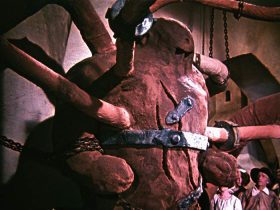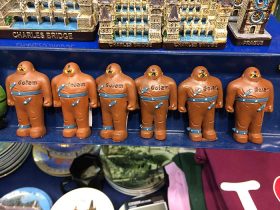They’re ubiquitous in Prague souvenir shops: clunky, mechanical golem figurines that owe their popularity to the 1951 film The Emperor and the Golem. The Czechoslovakian comedy classic, called Císařův pekař a pekařův císař in the original, was conceived by Martin Frič and Jiří Krejčík as a comedy of errors with political undertones. An irascible Emperor Rudolph II and his corrupt court are searching alternately for an elixir of youth and a recipe to turn lead into gold. But above all they want to find the legendary golem. This is the missing piece in the emperor’s cabinet of wonders and curiosities. On the search for the golem a brilliant switch takes place between Rudolf and his imperial baker, Matej. It’s an exchange from which both can profit in their different ways: the emperor with his private escapades and the baker for the good of all. The movie ends with a socialist message. The imperial bakery with all its granaries will now belong to its employees and even the powerful golem machine is tamed: the golem gets turned into a steaming baking automaton, by whose strength the people of Prague will be provided with bread to eat. Equality and justice are finally established.

Golem in the film The Emperor and the Golem, directors: Martin Fric and Jirí Krejcík, Czechoslovakia, 1951
© National Film Archive, Prague
Decades later the four-meter-high film prop, on the other hand, would generate a legal battle: the sculptor who designed the film’s golem, Jaroslav Horejc, had a daughter and she claimed the rights to reproduce its image. In the streets of Prague, in the wax museum, on corporate signage — you encounter the iconic figure simply everywhere. In 2010 a Prague court awarded her the copyright to the film’s golem, succeeding her father.
The golem of Horejc’s sculpture was the first figure of this kind to appear without any human features, whose robotic image emphasized aspects of modern everyday reality. Horejc’s golem became a source of visual inspiration. Similar to Paul Wegener’s golem with the unmistakable hair-do, who re-emerged in the Simpsons episode You Gotta Know When to Golem, or to the ghostly figure from Hugo Steiner-Prag’s lithography, whom Lord Voldemort uncannily resembled in the Harry Potter films, Horejc’s steam-machine from The Emperor and the Golem established its very own golem stock look.
We’re showing the film at 7 pm on 5 December 2016 as part of the program accompanying our Golem Exhibition (more information on the exhibit and on our screening of the film at our website).
Martina Lüdicke sometimes dreams of a golem that could bake fresh croissants.
